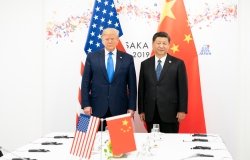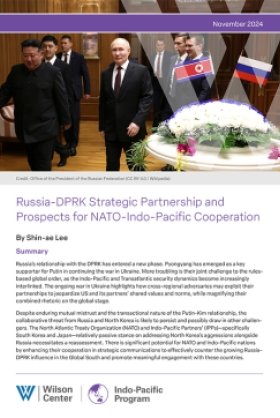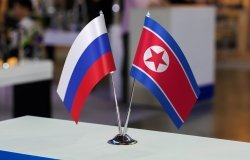U.S.-China Relations and Regional Order
Not only is the world in transition, but the process of transition in East Asia has speeded up since the global financial crisis in 2008, and especially since the leadership change in China two and a half years ago. Is the United States keeping up with these changes or is it mired in an effort to protect the status quo, while ceding to others control over the direction of change? Does China have the capability to contest the U.S. position as the guarantor of East Asian security?
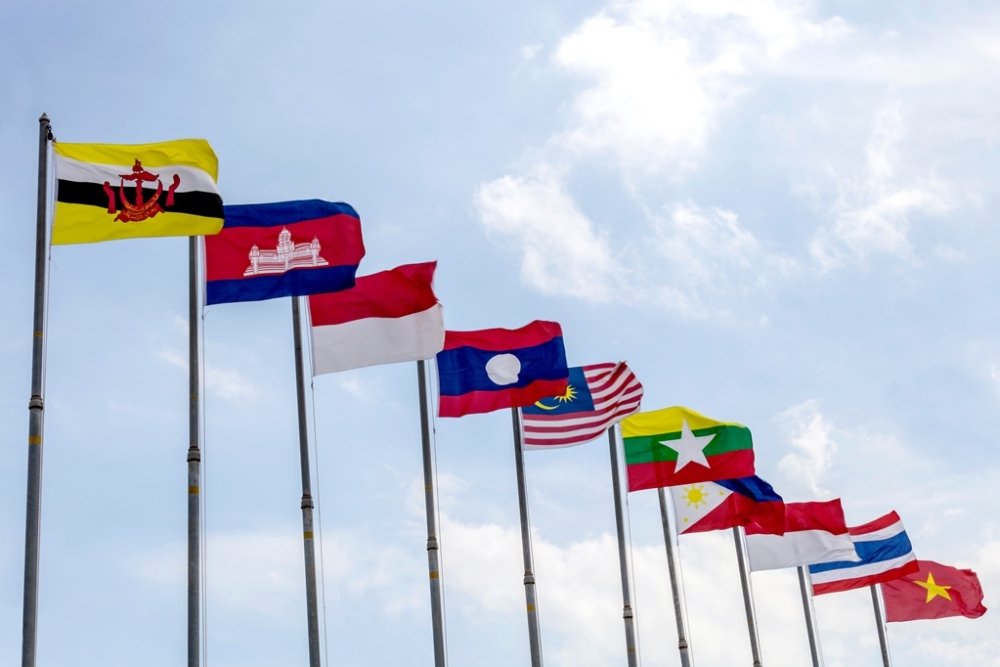
U.S.-China Relations and Regional Order was presented as the keynote address at Blurring Borders: National, Subnational, and Regional Orders in East Asia on June 1, 2015. The webcast of the event can be viewed here. A PDF version is available for download below.
East Asia brings together the interests of many of the world’s largest and most powerful countries.
In terms of population size, the number one, the number three, and the number four countries are located or have vital interests in East Asia: China, the United States, and Indonesia, and India is just over the horizon.
In terms of military power, the United States, China, Russia, and Japan rank among the top military powers in the world, and South Korea, Indonesia, and Vietnam have significant military capabilities. North Korea has also developed a limited nuclear weapons capability, which it has begun to use to threaten its neighbors
If we look at the 25 largest economies in the world, as listed in the CIA’s World Fact Book, we find that China now has the largest GDP in the world, measured in terms of purchasing power parity, followed by the European Union and the United States. Each of the top three has an economy exceeding $17 trillion in size. The next two major economies are Asian (Japan and India).
Twenty-one of the top twenty-five, excluding the individual EU members from the list, are from Asia, the Middle East, Africa, and Latin America. The combined GDP of these 21 countries is $13 trillion dollars greater than the combined GDP of the United States, Canada, Russia, and the EU. When I last did these calculations two years ago, this differential was $3 trillion, so the gap has widened significantly in just a few years. This is not the way the world looked just thirty years ago.
This diffusion of power in the world is reflected in the nature of the new organizations that are becoming features of the international scene. The roster of these new organizations includes the BRICS (Brazil, Russia, India, China, and South Africa), the Shanghai Cooperation Organization, the ASEAN Plus Three, the Group of 20, the East Asia Summit, the ASEAN Defense Ministers Meeting-Plus, the Shangri-La Dialogue, the Asia Infrastructure Investment Bank, and the BRICS Bank. Twenty years ago these organizations did not exist.
Not only is the world in transition, but the process of transition in East Asia has speeded up since the global financial crisis in 2008, and especially since the leadership change in China two and a half years ago. The question is whether the United States is keeping up with these changes or is mired in an effort to protect the status quo, while ceding to others control over the direction of change. The evidence suggests that the United States is still adjusting to the challenge of dealing with a different sort of China under its new dynamic leader Xi Jinping.
In the two plus years since Xi Jinping assumed China's top leadership position, he has moved boldly on both the domestic and foreign fronts. In the process he has confused many observers by combining Dengist pragmatism, Maoist ideology, and Adam Smith's devotion to the market.
Internationally, Xi has backed a muscular foreign policy focused on defending China's territorial claims and enhancing China's leadership role in the region. At the same time, he has called for a new type of great power relationship between China and the United States that can head off destructive strategic rivalry.
Under President Xi, China has moved away from Deng's prescription that China should keep a low profile while pursuing economic development. China now boasts of having a pro-active foreign policy. President Xi has launched a series of proposals that have a distinctive Chinese brand identification.
At the very least, this pattern of activity suggests that China under Xi Jinping is seeking to carve out a leadership role in Asia that is equal to or greater than that of the United States. Xi is committing major Chinese resources to pursuit of this goal. This is quite different from the proposition that China is seeking to drive the United States out of Asia. While Chinese leaders may, in their heart of hearts, prefer to see a major reduction in the U.S. role in East Asia, they are realistic enough to realize that for the foreseeable future they lack both the capability and the regional support to bring about that outcome.
China does have the capability, however, to contest the U.S. position as the guarantor of East Asian security, a role the United States has played since World War II. If China has this ambition, this would pose a challenge to the United States in at least two distinct but interconnected areas:
- If China’s rise gradually forces changes in the Pax Americana that has been a vital factor in the East Asian success story, what can emerge to replace it? And,
- Can a different stable order be crafted in East Asia where the disparities between the various players are so great, far greater than in Europe?
In thinking about these questions, we need to adopt a long term perspective. For the foreseeable future, the United States has the capability to keep current arrangements in place. Moreover, whatever China’s ambitions are, it has not yet launched an overt effort to overturn the U.S.-backed security order and usher in new arrangements more to its liking, although we are seeing inklings of what may lie ahead.
Some think the Chinese goal is to recreate an East Asian order modeled on older dynastic models. This is fanciful. The past cannot be recreated. While China remains geographically the central country in East Asia, it now must function in a Westphalian system in which both it and its neighbors all jealously guard their independence and sovereignty. Modern weapons make it dangerous, even for major powers, to resort to the military tactics of earlier historical periods. We are more likely to see a multipolar world with a number of powerful actors, and a larger group of lesser but strong subordinate players.
The question is whether a stable balance is possible within such a configuration. And whether the United States can operate effectively within a multipolar world. The United States lacks a tradition of balance of power diplomacy. Nor does our political system consistently generate leaders with the grasp of world affairs and the experience necessary to implement such an approach. Our experience on the international stage and our disposition as a country, which George Kennan characterized as a legalistic-moralistic approach to foreign affairs, is better suited to bipolar situations where we can see clear distinctions between good guys and bad guys, to put it crudely.
After WWII, we took on the role of a global balancer, bearing the principal burden in both Asia and Europe of not letting communist expansionism shift the balance in favor of the socialist states. In doing so in this bipolar context, we used the classic tools of balance of power practitioners, forming alliances and fighting wars to keep the balance stable. The Russians did the same, forging the Warsaw Pact, establishing alliances with China and North Korea and intervening militarily in Hungary, Czechoslovakia, and Afghanistan.
With the collapse of the Soviet Union, the role of the United States has shifted. Our recent wars have more to do with ideology and resources than with balance of power considerations. Our post-Cold War presidents are foreign to geo-strategic thinking. We recognize the need to balance China's rise, but we are using legacy alliances rather than forging new ones, and we are becoming more cautious in risking combat with significant foes.
China cannot step into the U.S. role as a global balancer.
Even if it aspired to, it would be decades before it could credibly assume this role, and world conditions are unlikely to be conducive to any country playing this role. If the United States loses the will to continue bearing this burden, there will be no global balancer, and the international order will consist of an amalgam of various regional and sub-regional orders determined by the dominant players in each region.
China is far from ready to take on global security responsibilities. In addition, Chinese nationalism is driven by the view that the international system has given inadequate attention to China's core interests. This sense of grievance is a burden for Chinese foreign policy, since it alarms China’s neighbors, who are concerned that a stronger China may seek to settle old scores.
Moreover China has to consider multiple security threats and not simply those on its Pacific borders. On its western frontiers, Chinese security interests intersect and potentially collide with those of Russia in the now independent states of the former Soviet Union. It is interesting in this respect that Chinese President Xi Jinping floated his proposal for a new Asian security and cooperation architecture at the May 2014 meeting of the Conference on Interaction and Confidence-Building Measures in Asia, an organization where only seven of the 26 members are located in East Asia. The other 19 members are located in South and Central Asia and the Middle East.
However, this brings us to the second challenge, which is whether we are prepared to commit the resources necessary to compete with a China whose GDP growth is outpacing that of the United States. The immediate indicators are not encouraging.
The situation was summed up nicely last year in a Majority Staff Study by the Senate Foreign Relations Committee on the Rebalance:
The United States has successfully moved forward with the initial phases of implementing the military aspects of the rebalance. But given the broader strategic and policy goals, it is essential that the non-military elements also move forward with equal speed and weight. An ‘unbalanced’ or under-resourced approach to the rebalance threatens to undermine the goals of the policy and, consequently, the prospects for greater prosperity and security in both the Asia-Pacific region and the United States.
In my view, this is an accurate statement of the problem. But it leaves us to wrestle with the question of what kind of order can preserve a stable balance in East Asia. China is obviously a central factor in this equation.
China's growing wealth and power provide fertile ground for the emergence of overweening ambitions to dominate the region. There is a lively debate underway in China over how assertive Beijing should be in carving out a dominant sphere of influence economically, politically, and eventually in the military sphere as well. China's ardent nationalists are not shy in pushing forward ambitious goals.
And yet, we should bear in mind that in sharp contrast to the Soviet Union, China's economic development has vastly improved many aspects of life in China, even while creating health-threatening environmental degradation. Seeking to inhibit China's growth would be bad policy and bad morality. Rather, the goal should be to increase the incentives for China to behave as a responsible power, even when its impulses are to let China's interests override those of its neighbors.
East Asia offers suitable conditions for achieving this goal. Three factors are necessary, although perhaps not sufficient:
- A level of solidarity among the ASEAN countries that can keep China from pursuing divide and rule tactics.
- A strong American presence at the level necessary to inspire confidence in China's neighbors, and among U.S. allies, that China does not have a free hand to browbeat them.
- A reinforcing structure of regional organizations and mutually agreed legal principles that can help deter irresponsible behavior by China or anyone else.
The first factor, ASEAN solidarity, is in place. But it is facing new challenges. Solidary has been weakened by the heating up of the dispute over islands in the South China Sea, where only four of the ten members have equities in the game. Additionally, progress has stalled on negotiating a Code of Conduct for the South China Sea, which China and the ten ASEAN members set as a goal in 2002.
The second factor, a reassuring U.S. presence, is also in place. Nevertheless, as noted earlier, it is excessively weighted on the military side. Moreover, U.S. support for giving Japan an expanded security role in East Asia and elsewhere is not welcomed by the ROK, America's other key ally in Northeast Asia. Despite expanded U.S.-PRC military-to-military contacts, strategic rivalry between China and the United States is continuing to intensify. These issues require constant attention.
The third factor, a reinforcing structure of regional organizations and legal principles, is still a work in progress. A lot has been accomplished in this area over the last two decades, but here an important transition is also taking place. Ever since the Asian Financial Crisis in 1997, the ASEAN countries have taken the lead in creating the new economic and security cooperation architecture that has emerged in East Asia. The view that the relatively weak ASEAN countries, rather than the powerful countries in Northeast Asia should take the lead was enshrined in the concept of “ASEAN centrality.”
China has now brushed this concept aside and is launching its own ideas, such as President Xi Jinping’s proposals last year for the creation of a new security and cooperation architecture in Asia and the Asia Pacific region. This concept was repeated in China’s recently released White Paper on military strategy, which speaks of promoting the establishment of a regional framework for security and cooperation, but provides no details.
While the Chinese have not clarified what they have in mind, President Xi’s terminology is reminiscent of the Conference on Security and Cooperation in Europe (CSCE) that emerged in the latter years of the Cold War. This organization existed alongside NATO and the Warsaw Pact.
With the disintegration of the Soviet Union, the CSCE transformed itself into the Organization on Security and Cooperation in Europe which continues to function to this day. It has dealt with such issues as arms control, border management, combating terrorism, conflict prevention, military reform, and policing. My point is not to endorse this proposal but to suggest that in the face of changing circumstances it is prudent to liberate the mind and think creatively.
The instinctive U.S. reaction has been to resist such proposals. We are keeping our existing alliances in good shape, but our major new initiative has been in the economic/trade sphere in the form of the Trans-Pacific Partnership, whose success is not yet assured.
A good step toward creating a more positive order in East Asia would be for China and the United States to work together, in cooperation with other countries, to strengthen the rule of law in the maritime space in the western Pacific and establish ground rules for avoiding confrontation. The 2002 Declaration on the Conduct of Parties in the South China Sea was an excellent beginning, but the follow through has lagged. The military to military confidence building measures announced at the Beijing summit set a good example. For its part, the United States needs to try harder to secure ratification of UNCLOS.
President Xi Jinping has pointed the way toward a basis for such cooperation. In his recent Work Conference speech, in which he said that China should "promote peaceful resolution of differences and disputes between countries through dialogue and consultation, and oppose the willful use or threat of force." He went on to say that China should "firmly uphold China's territorial sovereignty, maritime rights and interests and national unity, and properly handle territorial and island disputes . . . ." The United States can support the concept that promoting peaceful resolution of differences and disputes between countries through dialogue and consultation, opposing the willful use or threat of force, and properly handling territorial and island disputes is the right way to uphold China's territorial sovereignty, or that of any country.
In the same speech, President Xi was reported to have stressed that Chinese "should be keenly aware of the protracted nature of the contest over the international order." In my view, it is unfortunate he chose to put this in terms of a "contest." Sensible people everywhere recognize that the post-World War II international order needs to be adapted to take into account the new realities in the world, just as regional orders need to adjust as circumstances change. Far better to have this occur through a cooperative process rather than through a contest that produces winners and losers.
In recent decades East Asia has been in large measure a success story. We should keep it that way. So let's not exaggerate our differences. What is needed is boldness and willingness to act creatively and unconventionally in pursuit of an outcome based on common interest.
Documents & Downloads
About the Author
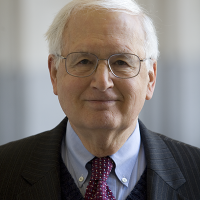
J. Stapleton Roy
Founding Director Emeritus, Kissinger Institute on China and the United States

Kissinger Institute on China and the United States
The Kissinger Institute works to ensure that China policy serves American long-term interests and is founded in understanding of historical and cultural factors in bilateral relations and in accurate assessment of the aspirations of China’s government and people. Read more



